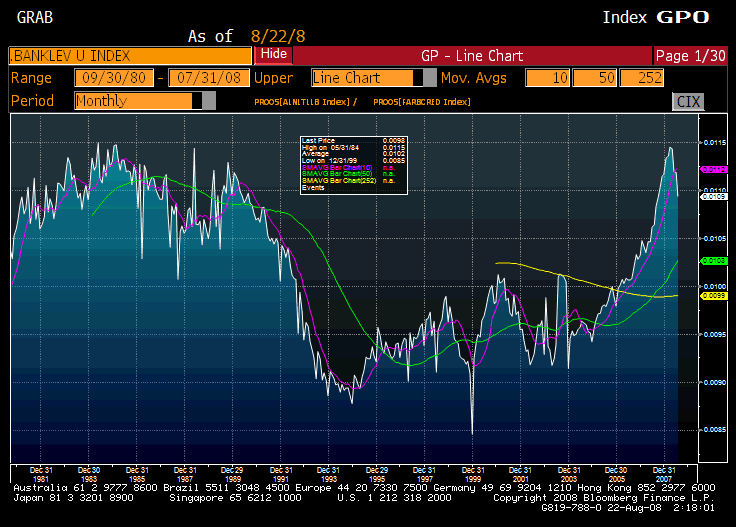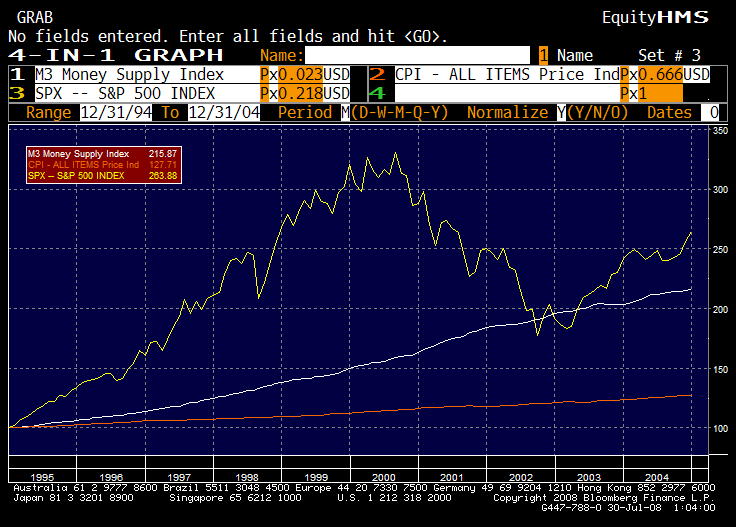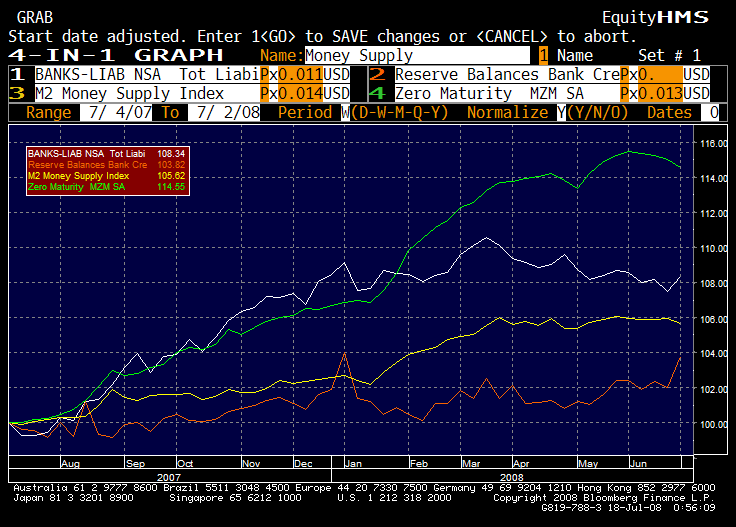A large-ish number of people have asked me to write this piece.? For those with access to RealMoney, I did an article called The Fundamentals of Market Tops.? For those without access, Barry Ritholtz put a large portion of it at his blog.? (I was honored  .) When I wrote the piece, some people who were friends complained, because they thought that I was too bullish.? I don?t know, liking the market from 2004-2006 was a pretty good idea in hindsight.
.) When I wrote the piece, some people who were friends complained, because they thought that I was too bullish.? I don?t know, liking the market from 2004-2006 was a pretty good idea in hindsight.
I then wrote another piece applying the framework to residential housing in mid-2005, and I came to a different conclusion? ? yes, residential real estate was near its top.? My friends, being bearish, and grizzly housing bears, heartily approved.
So, a number of people came to me and asked if I would write ?The Fundamentals of Market Bottoms.?? Believe me, I have wanted to do so, but some of my pieces at RealMoney were ?labor of love? pieces.? They took time to write, and my editor Gretchen would love them to death.? By the way, if I may say so publicly, the editors at RealMoney (particularly Gretchen) are some of their hidden treasures.? They really made my writing sing.? I like to think that I can write, but I am much better when I am edited.
Okay, before I start this piece, I have to deal with the issue of why equity market tops and bottoms are different.? Tops and bottoms are different primarily because of debt and options investors.? At market tops, typically credit spreads are tight, but they have been tight for several years, while seemingly cheap leverage builds up.? Option investors get greedy on calls near tops, and give up on or short puts.? Implied volatility is low and stays low.? There is a sense of invincibility for the equity market, and the bond and option markets reflect that.
Bottoms are more jagged, the way corporate bond spreads are near equity market bottoms.? They spike multiple times before the bottom arrives.? Investors similarly grab for puts multiple times before the bottom arrives.? Implied volatility is high and jumpy.
As a friend of mine once said, ?To make a stock go to zero, it has to have a significant slug of debt.?? That is what differentiates tops from bottoms.? At tops, no one cares about debt or balance sheets.? The only insolvencies that happen then are due to fraud.? But at bottoms, the only thing that investors care about is debt or balance sheets.? In many cases, the corporate debt behaves like equity, and the equity is as jumpy as an at-the-money warrant.
I equate bond spreads and option volatility because contingent claims theory views corporate bondholders as having sold a put option to the equityholders.? In other words, the bondholders receive a company when in default, but the equityholders hang onto it in good times.? I described this in greater measure in Changes in Corporate Bonds, Part 1, and Changes in Corporate Bonds, Part 2.
Though this piece is about bottoms, not tops, I am going to use an old CC post of mine on tops to illustrate a point.

 |
 |
David Merkel |
| Housing Bubblettes, Redux |
10/27/2005 4:43 PM EDT
 |
From my piece, ?Real Estate?s Top Looms?:
Bubbles are primarily a financing phenomenon. Bubbles pop when financing proves insufficient to finance the assets in question. Or, as I said in another forum: a Ponzi scheme needs an ever-increasing flow of money to survive. The same is true for a market bubble. When the flow?s growth begins to slow, the bubble will wobble. When it stops, it will pop. When it goes negative, it is too late.
As I wrote in the column on market tops: Valuation is rarely a sufficient reason to be long or short a market. Absurdity is like infinity. Twice infinity is still infinity. Twice absurd is still absurd. Absurd valuations, whether high or low, can become even more absurd if the expectations of market participants become momentum-based. Momentum investors do not care about valuation; they buy what is going up, and sell what is going down.
I?m not pounding the table for anyone to short anything here, but I want to point out that the argument for a bubble does not rely on the amount of the price rise, but on the amount and nature of the financing involved. That financing is more extreme today on a balance sheet basis than at any point in modern times. The average maturity of that debt to repricing date is shorter than at any point in modern times.
That?s why I think the hot coastal markets are bubblettes. My position hasn?t changed since I wrote my original piece.
Position: none
I had a shorter way of saying it: Bubbles pop when cash flow is insufficient to finance them.? But what of market bottoms?? What is financing like at market bottoms?
The Investor Base Becomes Fundamentally-Driven
1) Now, by fundamentally-driven, I don?t mean that you are just going to read lots of articles telling how cheap certain companies are. There will be a lot of articles telling you to stay away from all stocks because of the negative macroeconomic environment, and, they will be shrill.
2) Fundamental investors are quiet, and valuation-oriented.? They start quietly buying shares when prices fall beneath their threshold levels, coming up to full positions at prices that they think are bargains for any environment.
3) But at the bottom, even long-term fundamental investors are questioning their sanity.? Investors with short time horizons have long since left the scene, and investor with intermediate time horizons are selling.? In one sense investors with short time horizons tend to predominate at tops, and investors with long time horizons dominate at bottoms.
4) The market pays a lot of attention to shorts, attributing to them powers far beyond the capital that they control.
5) Managers that ignored credit quality have gotten killed, or at least, their asset under management are much reduced.
6) At bottoms, you can take a lot of well financed companies private, and make a lot of money in the process, but no one will offer financing then.? M&A volumes are small.
7) Long-term fundamental investors who have the freedom to go to cash begin deploying cash into equities, at least, those few that haven?t morphed into permabears.
8 ) Value managers tend to outperform growth managers at bottoms, though in today?s context, where financials are doing so badly, I would expect growth managers to do better than value managers.
9) On CNBC, and other media outlets, you tend to hear from the ?adults? more often.? By adults, I mean those who say ?You should have seen this coming.? Our nation has been irresponsible, yada, yada, yada.?? When you get used to seeing the faces of David Tice and James Grant, we are likely near a bottom.? The ?chrome dome count? shows more older investors on the tube is another sign of a bottom.
10) Defined benefit plans are net buyers of stock, as they rebalance to their target weights for equities.
11) Value investors find no lack of promising ideas, only a lack of capital.
12) Well-capitalized investors that rarely borrow, do so to take advantage of bargains.? They also buy sectors that rarely attractive to them, but figure that if they buy and hold for ten years, they will end up with something better.
13) Neophyte investors leave the game, alleging the the stock market is rigged, and put their money in something that they understand that is presently hot ? e.g. money market funds, collectibles, gold, real estate ? they chase the next trend in search of easy money.
14) Short interest reaches high levels; interest in hedged strategies reaches manic levels.
Changes in Corporate Behavior
1) Primary IPOs don?t get done, and what few that get done are only the highest quality. Secondary IPOs get done to reflate damaged balance sheets, but the degree of dilution is poisonous to the stock prices.
2) Private equity holds onto their deals longer, because the IPO exit door is shut.? Raising new money is hard; returns are low.
3) There are more earnings disappointments, and guidance goes lower for the future.? The bottom is close when disappointments hit, and the stock barely reacts, as if the market were saying ?So what else is new??
4) Leverage reduces, and companies begin talking about how strong their balance sheets are.? Weaker companies talk about how they will make it, and that their banks are on board, committing credit, waiving covenants, etc.? The weakest die.? Default rates spike during a market bottom, and only when prescient investors note that the amount of companies with questionable credit has declined to an amount that no longer poses systemic risk, does the market as a whole start to rally.
5) Accounting tends to get cleaned up, and operating earnings become closer to net earnings.? As business ramps down, free cash flow begins to rise, and becomes a larger proportion of earnings.
6) Cash flow at stronger firms enables them to begin buying bargain assets of weaker and bankrupt firms.
7) Dividends stop getting cut on net, and begin to rise, and the same for buybacks.
8 ) High quality companies keep buying back stock, not aggresssively, but persistently.
Other Indicators
1) Implied volatility is high, as is actual volatility. Investors are pulling their hair, biting their tongues, and retreating from the market. The market gets scared easily, and it is not hard to make the market go up or down a lot.
2)The Fed adds liquidity to the system, and the response is sluggish at best.? By the time the bottom comes, the yield curve has a strong positive slope.
No Bottom Yet
There are some reasons for optimism in the present environment.? Shorts are feared.? Value investors are seeing more and more ideas that are intriguing.? Credit-sensitive names have been hurt.? The yield curve has a positive slope.? Short interest is pretty high.? But a bottom is not with us yet, for the following reasons:
- Implied volatility is low.
- Corporate defaults are not at crisis levels yet.
- Housing prices still have further to fall.
- Bear markets have duration, and this one has been pretty short so far.
- Leverage hasn?t decreased much.? In particular, the investment banks need to de-lever, including the synthetic leverage in their swap books.
- The Fed is not adding liquidity to the system.
- I don?t sense true panic among investors yet.? Not enough neophytes have left the game.
Not all of the indicators that I put forth have to appear for there to be a market bottom. A preponderance of them appearing would make me consider the possibility, and that is not the case now.
Some of my indicators are vague and require subjective judgment. But they?re better than nothing, and kept me in the game in 2001-2002. I hope that I ? and you ? can achieve the same with them as we near the next bottom.
For the shorts, you have more time to play, but time is running out till we get back to more ordinary markets, where the shorts have it tough.? Exacerbating that will be all of the neophyte shorts that have piled on in this bear market.? This includes retail, but also institutional (130/30 strategies, market neutral hedge and mutual funds, credit hedge funds, and more).? There is a limit to how much shorting can go on before it becomes crowded, and technicals start dominating market fundamentals.? In most cases, (i.e. companies with moderately strong balance sheets) shorting has no impact on the ultimate outcome for the company ? it is just a side bet that will eventually wash out, following the fundamental prospects of the firm.
As for asset allocators, time to begin edging back into equities, but I would still be below target weight.
The current market environment is not as overvalued as it was a year ago, and there are some reasonably valued companies with seemingly clean accounting to buy at present.? That said, long investors must be willing to endure pain for a while longer, and take defensive measures in terms of the quality of companies that they buy, as well as the industries in question.? Long only investors must play defense here, and there will be a reward when the bottom comes.






